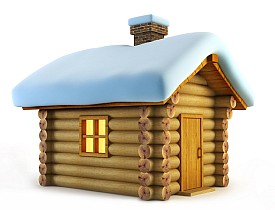Which Roof is Right for Your Climate?
 Home improvement warehouse stores and Web sites tend to sell the same types of roofing in all areas, but roofing needs are not the same in every climate and region. Whether you plan to install your own DIY roof or hire a roofing contractor for the job, it's important to know the best options for your region. Find out which materials to use and which materials to avoid, depending on the climate where you live.
Home improvement warehouse stores and Web sites tend to sell the same types of roofing in all areas, but roofing needs are not the same in every climate and region. Whether you plan to install your own DIY roof or hire a roofing contractor for the job, it's important to know the best options for your region. Find out which materials to use and which materials to avoid, depending on the climate where you live.
Roofs for Tropical Climates
If your home is in a humid climate with high precipitation, it's a priority to avoid algae growth from all that dampness on the roof.
Asphalt shingles are attractive, durable and inexpensive, making them the most popular roofing material in the United States. However, only asphalt shingles with algicides are appropriate for humid climates.
Metal roofing is an excellent choice in wet areas. New metal roof options are rust-resistant and waterproof. The solid metal surface also resists algae. Hail might dent metal, but hail can damage almost any roof. Hurricane-force winds (like you’ll encounter in Florida) can blow shingles off the roof, but flat sheets of metal roofing have more wind resistance than most shingle roofing.
Roofs to Beat the Heat
Homeowners in extremely hot desert climates need a roof that will not absorb heat and draw it into the house.
Rubber roofing will be painfully hot if you are working on it in the summer, and it will draw heat into the house. Although it's possible to find light shades of asphalt shingles, they are still darker than many metal and tile colors. Metal roofs can also be hot to the touch, but light shades of metal reflect sunlight.
Clay tile roofing is a very popular option in Arizona, Nevada, and other desert climates for good reasons. It is more expensive than metal or shingles, but it blocks heat and is relatively wind-resistant. Keep in mind that installing tile roofing requires training and special tools, so it is not a DIY project. In many areas, expert tile installers can be tough to find.
Roofs to Prevent Snow Damage
Roofs in the Midwest and other cold areas will lie under heavy piles of snow for months. Both slate and tile roofs are very heavy, which shouldn't prevent you from using these upscale options, however. Just keep in mind that your roof will require extra reinforcement to support both the roofing material and piles of heavy snow.
Unlike desert climates, cooler areas need dark roofing to absorb winter sunlight (when the roof is not covered in snow) and provide some free heating. Dark shingles can help draw heat into the home. However, again, they are lightweight and could be easily pulled off by a tornado. Rubber roofing, though unattractive, also retains heat and may be more wind-resistant.
In summary, metal roofing may be the best option for wet and humid areas, tile is ideal in the desert and shingles are a good idea in regions with harsh winters. Still, consider factors like house style and roofing costs, as well, to determine whether the "best option" is really the best option for your home.
This article was updated November 10, 2017.
Looking for a Pro? Call us (866) 441-6648

Roofing Average Costs
Roofers Experiences

Garage Roof Leak Repair Means No More Dripping Onto My Drywall

Time Was Of The Essence When My Tenants’ Roof Blew Off



